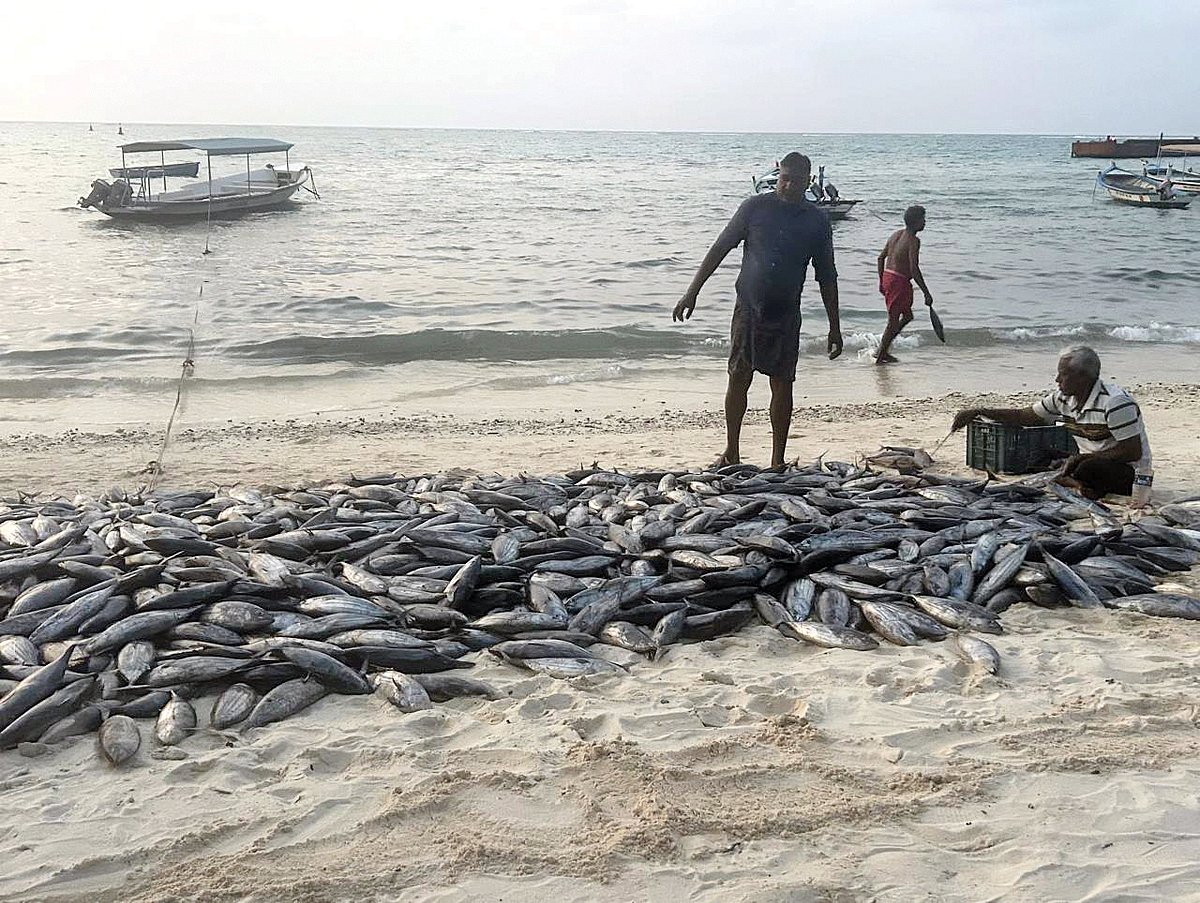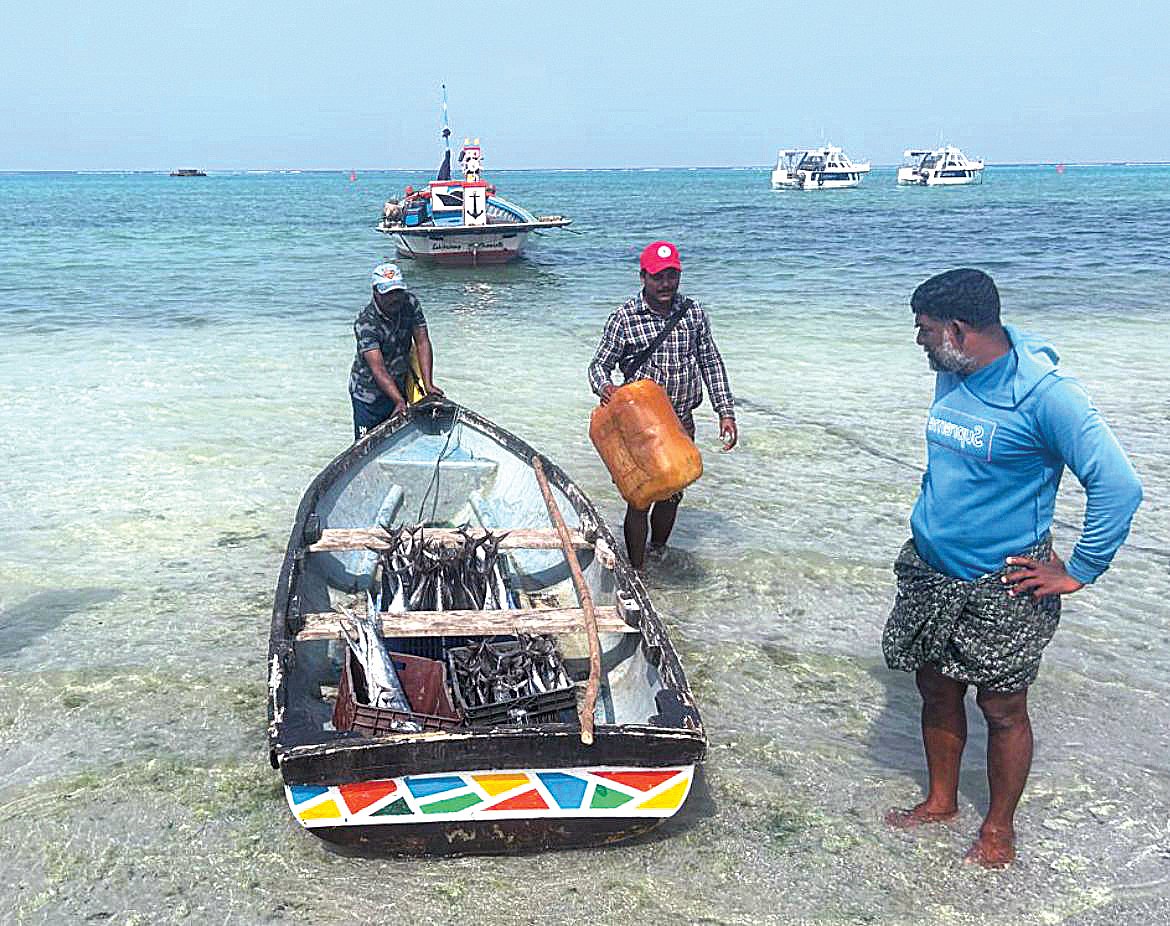India’s vanishing paradise in the sea
Lakshadweep, which taught India to fish sustainably, is struggling to keep its tradition afloat, writes K.A. Shaji

In 1961, a soft-spoken civil servant named Moorkoth Ramunni, a former Indian Air Force pilot, sailed across the Arabian Sea to take charge as administrator of Lakshadweep, then the Laccadive, Minicoy and Amindivi Islands. His brief from Prime Minister Jawaharlal Nehru was simply worded but profound in its scope — improve the living conditions of the islanders without destroying their way of life.
When Ramunni arrived at this paradisiac cluster of coral islands shimmering in turquoise lagoons, he realised it was home to a people deeply tied to the rhythm of the sea. He met Hussain Ali of Minicoy, who invited him on a tuna fishing trip. That journey would transform Ramunni and shape India’s approach to small island development for decades.
On a wooden boat rocking gently in the southern lagoon, Ramunni received his first lessons in the ancient art of pole-and-line tuna fishing. Fishermen used bamboo poles and live bait to bring tuna to the surface and catch them one by one. There were no trawls, no mechanised nets and minimal bycatch. It was skill and patience, not machines, that did the work.
“It was the most dignified form of fishing I had ever seen,” Ramunni later wrote in India’s Coral Islands in the Arabian Sea.
The pole-and-line method, believed to have arrived from the Maldives more than a thousand years ago, became the lifeline of Minicoy and several other southern islands. It allowed fishers to harvest fast swimming skipjack tuna and yellowfin tuna without endangering juvenile species or fragile coral habitats.
“Pole-and-line fishing is not just a technique,” says Muhsin Ali, a Kavaratti-based tuna expert. “It is a philosophy of balance. It respects the sea’s limits. Every fish caught is a conscious act.”
Lakshadweep’s tuna, locally dried into a flaky delicacy called ‘mas’, found demand in Sri Lanka, Japan and increasingly in Western markets, where sustainably caught seafood commands a premium. More importantly, pole-and-line fishing protected the islands’ marine ecosystem and provided livelihoods for thousands of families.


To preserve this ecological balance and social fabric, India promulgated the Laccadive, Minicoy and Amindivi Islands Protection of Scheduled Tribes Regulation Act of 1964. The law granted Scheduled Tribe status to islanders and barred outsiders from buying, leasing or mortgaging land in the archipelago.
‘The tribal islanders needed protection from mainland exploitation,’ Ramunni wrote. ‘We saw what happened in Kerala’s tribal belts, where land and culture were lost. We could not let that happen here.’
For decades, the regulation acted like a protective reef. It shielded Lakshadweep from commercial encroachment and kept mainland fishing lobbies and industrial trawlers at bay, preserving pole-and-line as both an economic and ecological lifeline
The changing tide
That balance is now under strain. In the recent Union Budget, finance minister Nirmala Sitharaman announced a plan to unlock ‘the untapped potential’ of the marine sector by expanding tuna harvesting for export from the Andaman and Nicobar Islands and Lakshadweep.
To some, that might sound like an opportunity. To others, it is a death warrant. “Tuna is the new gold,” says Charles George, president of the Kerala Fish Workers’ Union. “But a gold rush means plunder. The islands cannot survive industrial fishing.”
The Central Marine Fisheries Research Institute has warned that some of India’s fish stocks are already under pressure. As stocks decline along the mainland coasts, corporate trawlers and purse seiners are eyeing the deep seas around Lakshadweep, one of the last relatively undisturbed tuna habitats in the Indian Ocean.
“If Lakshadweep opens up to industrial fleets, it will be ecological suicide,” says K.V. Thomas, a retired fisheries scientist. “These coral islands are not just dots on a map. They are living organisms. If you disturb their balance, recovery is very difficult.”
At dawn, the lagoon around Agatti turns pink and silver. Monitoring data Some atolls such as Kadmat and Kalpeni have lost over half their live coral cover. Even Agatti’s outer reef, once a rainbow of life, looks pale and exhausted.
As corals die, these islands lose the natural barriers that protect them from storms and erosion. Sandbanks erode and lagoons destabilise. Corals built these islands over thousands of years; when the living part dies, the island itself becomes fragile.
Near the jetty in Kavaratti, M. Nasar, a veteran scuba diver, prepares for his morning descent. “When I started diving thirty years ago, the reef was a forest,” he remembers. “Fish crackled underwater. Corals had colour and movement. Now it is silent.” Nasar describes diving during the last bleaching season and watching corals lose their colour before his eyes. “It was like watching a friend die slowly,” he says.
The silence under the water has an economic echo above it. Reef fish such as parrotfish, surgeonfish and snappers have disappeared, crippling small fishers who relied on them for daily income. “Earlier, our nets were full by sunrise,” Nasar says. “Now we go farther and catch less.”
Pole-and-line fishing depends on baitfish, small reef species caught in lagoons to attract tuna. As reefs collapse, baitfish vanish too. “We used to find bait near the island,” says Muhsin Ali. “Now we must travel far into deeper water. Without bait, pole-and-line cannot work.”
The rising fuel costs and longer trips make the traditional method less viable. Some boats are idle. Young men who once learned the craft from elders are tempted by other work on the mainland. “We are not asking for charity,” says Abdul Salam, a fish worker and community leader. “We [want] the sea to live. How will it sustain without the ecosystem that supports it.”
Inland, the crisis is visible in the wells. Freshwater lenses that once supplied islanders with drinking water are collapsing as the seawater intrudes. “Every home had a well. Now we rely on desalination plants,” says Salam.
Coconut palms are withering as their roots absorb salt. Kitchen gardens are abandoned. The green canopy that shaded homes has thinned. “The sea is entering our soil,” he says. “It is changing the very taste of life.”
The eroding shoreline
At Agatti’s edge, schoolteacher Ali Murarack points to a line of coconut stumps half-buried in surf. “That used to be our football ground,” he says. Each monsoon takes another slice of land.
Concrete seawalls only shift the problem further down the coast. Earlier the reef absorbed the waves. Now the waves hit the land directly. “It feels like living on a crumbling plate.” The school Ali teaches in had to move its boundary twice in five years. “We teach climate change in class,” he says. “But the shoreline itself is our blackboard.”
Near the lagoon edge in Kavaratti, a mountain of plastic waste rises against the sea. Discarded bottles, broken nets and packaging material accumulate with no safe disposal site. During the last monsoon, a fire at a dump in Minicoy burned for days.
"Where can we put the waste? We have no landfills and shipping waste to the mainland is costly,” says P.K. Noushad, a tourism worker. “Tourists come for clean lagoons and leave their garbage behind. Every plastic bag that floats in the lagoon hurts coral. Tourism shouldn’t destroy the habitat it wishes to explore.”
…and the ‘development’ nightmare
The administration’s push for more resorts and infrastructure promises jobs and connectivity, but it also brings anxiety. Dredging lagoons, cutting vegetation and mining sand for construction alters the delicate reef-lagoon balance that sustains the islands. “Every time there is a new project, we lose another piece of the island,” Noushad says. “The mainland can build more hotels. We cannot build more land.”
Experts argue that Lakshadweep’s development model must remain low impact. “Eco-tourism can sustain the islands,” says A. Biju Kumar, head of the Department of Aquatic Biology and Fisheries at the University of Kerala. “Mass tourism will destroy them. Once coral dies, no amount of concrete will replace the reef.”
The Arabian Sea is warming faster than the global average, research shows. Storms are now more violent, and the monsoon has become erratic. In 2017, Cyclone Ockhi brushed past the islands, uprooting trees and flooding homes. As the sea rises and coral dies, some uninhabited islets have already disappeared beneath the surf. Satellite images show shrinking beaches and shifting shorelines. The archipelago is changing shape.
Ocean chemistry is also changing. The sea absorbs carbon dioxide and becomes more acidic, making it harder for corals to build their calcium skeletons. “Even if temperatures stabilise, acidification will weaken reef structure,” says K.V. Thomas. “It is like the bones of the island are becoming porous.” Acidification affects plankton and shellfish and ripples up the food chain. For communities dependent on fish for food and income, this is an existential threat.
Recent studies from national marine institutes confirm what the islanders have long known — the coral cover has declined sharply in two decades. Algal blooms have replaced living coral, and fish populations are migrating. Researchers urge the designation of protected marine areas and community-led conservation to protect ‘thermal refugia’ where corals show resistance to heat.
“Some coral pockets in Minicoy are showing resilience,” says Luqman Muhammed, a doctoral researcher on Lakshadweep fisheries. “If we map and protect these thermal refugia, they can reseed damaged reefs. But time is short.”
Follow us on: Facebook, Twitter, Google News, Instagram
Join our official telegram channel (@nationalherald) and stay updated with the latest headlines
